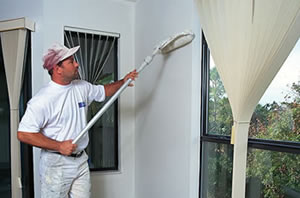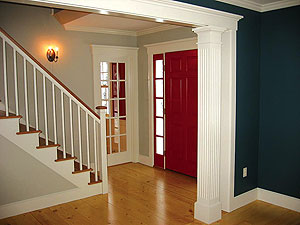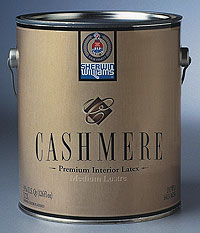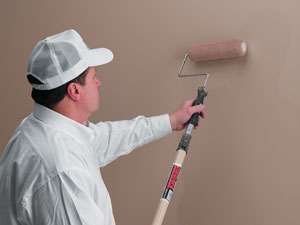|

Wall Paint, Eggshell Paint
Though there is disagreement as to what defines "eggshell," all agree that it's a popular choice for both homeowners and contractors.
by Liz Trauring
and every painter has used it. Manufacturers agree that eggshell outsells flat, yet there is no agreement on what an eggshell finish really is, exactly.
Eggshell finish was introduced sometime in the early- to mid-1970s as a more durable finish for the new latex flats, which tended to wipe off, not wipe clean. It provided a wall finish that was softer and less shiny than semigloss, but had some of the same durable properties, so dirty fingerprints could be washed off.
 Of course, the name of the finish is derived from the look of a real eggshell. "When you look straight at an egg's shell it looks flat, but if you look at it from an angle, you see that it has a little bit of sheen," explains Frank Magdits of Benjamin Moore & Co. Of course, the name of the finish is derived from the look of a real eggshell. "When you look straight at an egg's shell it looks flat, but if you look at it from an angle, you see that it has a little bit of sheen," explains Frank Magdits of Benjamin Moore & Co.
From a technical standpoint, eggshell has more resin than flat. "By raising the sheen, manufacturers took out some of the pigments that tend to burnish and replaced them with resin, which is the latex 'glue' that holds everything together," Magdits says. "This imparts good sealing properties, which explains its scrubbability."
Beyond that technical explanation, there is no agreement as to what constitutes an eggshell finish.
"There is no industry standard for product names," says Todd Braden, vice president of marketing for Rodda Paint. "In our market (the Northwest), there is a confusing distinction between satin, eggshell, low gloss and pearl luster. Not to mention the fact that some people think 'eggshell' is a color. Some of our lines offer an eggshell finish, but in others we have satin finishes."
Braden admits that Rodda's best-selling interior wall paint is an eggshell finish: Lasyn Eggshell. Yet, he says, "It is also the only product Rodda has left in its line designated as eggshell."
 Ron Boyajian, product-marketing manager for California Paints, agrees that there are no strict standards as to what a company can call an eggshell finish. "The sheen or gloss level is measured numerically," he explains. "Generally speaking, a flat would be from zero to five. An eggshell could be anywhere from five to 35. The scale is like a mirror, with 100 being a perfectly smooth, mirror surface. Semigloss runs between 35 and 70. So where do satin finishes come in? Anywhere between anything," he laughs Ron Boyajian, product-marketing manager for California Paints, agrees that there are no strict standards as to what a company can call an eggshell finish. "The sheen or gloss level is measured numerically," he explains. "Generally speaking, a flat would be from zero to five. An eggshell could be anywhere from five to 35. The scale is like a mirror, with 100 being a perfectly smooth, mirror surface. Semigloss runs between 35 and 70. So where do satin finishes come in? Anywhere between anything," he laughs
Actually, satin is listed in the Master Painter Institute's Gloss and Sheen Standards as being between 20 and 35. Not every manufacturer adheres to MPI's standards, although Rodda Paint is one of the manufacturers embracing the system of rating sheen levels by number rather than relying on a name. " It alleviates the mystery of what you're going to get." Braden says.
By using MPI's numeric sheen system, specifiers and architects can specify MPI #15, for example, instead of having to specify a particular product or its equal substitution by name. Any contractor bidding on the job can go to the MPI website to see which manufacturers' products are certified for that specification.
"Eggshell outsells flat two or three to one," Boyajian says. The eggshell finish in the company's 2010 Super Scrub Ceramic line rates about MPI #18, but the finish rates only #8 or #9 in its Fres-Coat and Pacific lines. "Our contractor-grade eggshells are generally a lot lower. Pro Paint, Pro 200 and Preference lines' eggshells run about #6, because lower sheen products are easier to touch up, and contractors like that."
Pittsburgh Paints' Manor Hall Timeless Eggshell Plus finish has a slightly higher sheen than traditional eggshells, but its cross-linking technology makes it extremely durable, says Susan Bardusch, marketing manager of consumer products. Jodi Pitchok, Pittsburgh Paints' commercial segment marketing manager, reports that Wall Hide's eggshell finish has a less porous paint surface than others, so it is easier to remove surface dirt without scrubbing.
When it comes to low-VOC or zero-VOC, eggshell finishes still do the job — mostly.
Sherwin-Williams has an eggshell finish in its zero-VOC Harmony line. The Duration Home line, which is environmentally compliant throughout the country, has a satin finish instead, but "the terms are definitely interchangeable," says vice president of marketing Steve Revnew. "Both finishes are extremely durable." In fact, Sherwin-Williams has an eggshell finish in virtually every line, including the professional lines of Pro Mar 400 and Pro Mar 200. "In addition," Revnew explains, "the ProMar 200XP eggshell has a heavier build, so it delivers the equivalent of two coats durability with only one coat."
Eggshell finish is standard across all the Muralo lines, says Shashi Patel, Muralo Co. executive vice president. "There may be variances in formula, but the sheen is the same in Ultra Waterborne, Superfinish and Power Hide." Patel agrees that eggshell's durability is what has lead to its immense popularity, but since the introduction of Muralo's matte flat, the new finish is making sales inroads. "People like being able to get the same washability as an eggshell finish without the shine."
As Mike Gaul of Gaul Painting, Bedminster, N.J., says, "Soccer moms love two things: their minivans and their eggshell finishes. Color is important, but they also want value. They want to be able to wash fingerprints and jelly stains off of their kid's bedroom walls without leaving smudge marks, and they want those same walls to be a nonglare backdrop for window treatments, art work and photographs. Eggshell finish meets both demands."
 Gaul cautions that he finds that some deep colors in eggshell finish have hiding difficulties over light colors, so he makes sure he uses deep tone primers to help alleviate this problem. Gaul cautions that he finds that some deep colors in eggshell finish have hiding difficulties over light colors, so he makes sure he uses deep tone primers to help alleviate this problem.
Finally, he recommends that contractors make sure all areas are uniformly primed when using eggshell finishes. If not, he says, "the sheen may look uneven, so I always use at least two coats of finish for the best job."
On the other hand, Jeff Arnold, Arnold Painting, Charlevoix, Mich., tries to never use eggshell finish anywhere except in the kitchen or bathroom. "I try to talk people into eggshell or pearl who want to use semigloss to protect the walls from moisture or food spatter, but customers tend to think they need a bigger sheen than they really do. They are always happier with an eggshell or at most, a pearl finish."
 Many decorative painters report that eggshell finish is their paint of choice for murals or other decorative effects. Joe Belisle of Belisle Art, Westchester County, N.Y., prefers to use Benjamin Moore's latex eggshell because he thinks it makes the best base to take an application of glaze. In fact, he uses eggshell paint for his mural artwork because, he says, "I never like to cover my work with any kind of clear coat. It always yellows, so I want the pure paint and glaze. Additionally, eggshell can be easily washed, which is important whether I'm doing murals in restaurants or in kids' rooms." Many decorative painters report that eggshell finish is their paint of choice for murals or other decorative effects. Joe Belisle of Belisle Art, Westchester County, N.Y., prefers to use Benjamin Moore's latex eggshell because he thinks it makes the best base to take an application of glaze. In fact, he uses eggshell paint for his mural artwork because, he says, "I never like to cover my work with any kind of clear coat. It always yellows, so I want the pure paint and glaze. Additionally, eggshell can be easily washed, which is important whether I'm doing murals in restaurants or in kids' rooms."
Belisle explains that sometimes water-based eggshells are too thick for detail work, so he uses an extender like Floetrol Latex Paint Conditioner. "It makes the paint flow much easier. If I'm doing a glaze finish and I don't want the paint to dry too quickly, I mix the glaze right into the paint, which gives me enough time to finish the effect I want."

|

